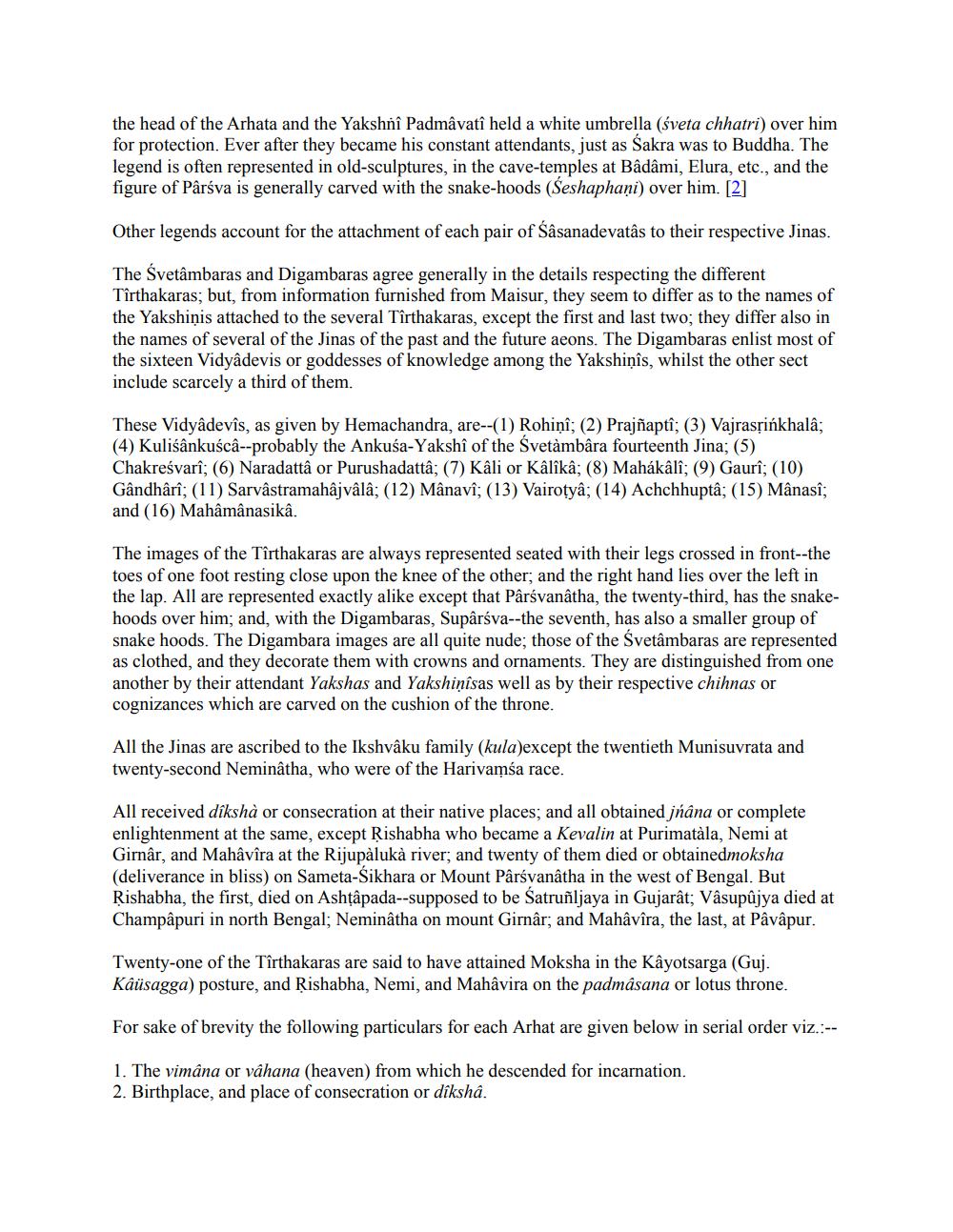________________
the head of the Arhata and the Yakshnî Padmâvatî held a white umbrella (sveta chhatri) over him for protection. Ever after they became his constant attendants, just as Sakra was to Buddha. The legend is often represented in old-sculptures, in the cave-temples at Bâdâmi, Elura, etc., and the figure of Parsva is generally carved with the snake-hoods (Seshaphani) over him. [2]
Other legends account for the attachment of each pair of Śâsanadevatâs to their respective Jinas.
The Svetâmbaras and Digambaras agree generally in the details respecting the different Tîrthakaras; but, from information furnished from Maisur, they seem to differ as to the names of the Yakshinis attached to the several Tîrthakaras, except the first and last two; they differ also in the names of several of the Jinas of the past and the future aeons. The Digambaras enlist most of the sixteen Vidyâdevis or goddesses of knowledge among the Yakshinîs, whilst the other sect include scarcely a third of them.
These Vidyådevis, as given by Hemachandra, are--(1) Rohini; (2) Prajñaptî; (3) Vajrasṛinkhala; (4) Kulisankuścâ--probably the Ankuša-Yakshi of the Svetambara fourteenth Jina; (5) Chakreśvari; (6) Naradatta or Purushadatta; (7) Kâli or Kâlika; (8) Mahákāli; (9) Gauri; (10) Gandhåri; (11) Sarvâstramahäjvälä; (12) Mânavi; (13) Vairotyå; (14) Achchhuptâ; (15) Mânasi; and (16) Mahâmânasikâ
The images of the Tirthakaras are always represented seated with their legs crossed in front--the toes of one foot resting close upon the knee of the other; and the right hand lies over the left in the lap. All are represented exactly alike except that Pârśvanátha, the twenty-third, has the snakehoods over him; and, with the Digambaras, Supâršva--the seventh, has also a smaller group of snake hoods. The Digambara images are all quite nude; those of the Svetâmbaras are represented as clothed, and they decorate them with crowns and ornaments. They are distinguished from one another by their attendant Yakshas and Yakshinisas well as by their respective chihnas or cognizances which are carved on the cushion of the throne.
All the Jinas are ascribed to the Ikshvâku family (kula)except the twentieth Munisuvrata and twenty-second Neminâtha, who were of the Harivamsa race.
All received dîkshà or consecration at their native places; and all obtained jnâna or complete enlightenment at the same, except Rishabha who became a Kevalin at Purimatàla, Nemi at Girnâr, and Mahâvîra at the Rijupàlukà river; and twenty of them died or obtainedmoksha (deliverance in bliss) on Sameta-Sikhara or Mount Pârsyanâtha in the west of Bengal. But Rishabha, the first, died on Ashtapada--supposed to be Satruñljaya in Gujarât; Vâsupûjya died at Champapuri in north Bengal; Neminatha on mount Girnår; and Mahavira, the last, at Påvapur.
Twenty-one of the Tîrthakaras are said to have attained Moksha in the Kâyotsarga (Guj. Kausagga) posture, and Rishabha, Nemi, and Mahavira on the padmasana or lotus throne.
For sake of brevity the following particulars for each Arhat are given below in serial order viz.:-
1. The vimâna or vâhana (heaven) from which he descended for incarnation. 2. Birthplace, and place of consecration or dîkshâ.




